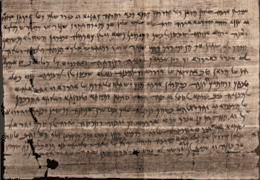Arsames (satrap of Egypt)
Arsames (also called Sarsamas and Arxanes, from Old Persian Aršāma[2]) was an Achaemenid satrap of ancient Egypt during the 5th century BC, at the time of the 27th Dynasty of Egypt.
| Arsames Satrap of Egypt | |
|---|---|
 Lower half of one of the Elephantine papyri, containing a plea for the reconstruction of the Jewish temple at Elephantine, and dated to "..the Year 17 of King Darius (II), under Arsames..." (407 BCE).[1] | |
| Predecessor | Achaemenes |
| Successor | possibly none (end of the satrapy of Egypt) |
| Dynasty | 27th Dynasty |
| Pharaoh | Artaxerxes I to Darius II |
Career
According to Ctesias, Sarsamas was appointed satrap by general Megabyzus.[3] Previously, an ancient Egyptian prince called Inaros openly revolted against Artaxerxes I and the Achaemenid rule and slain in battle the late satrap, Achaemenes. In 454 BC, shortly after his appointment, Arsames helped quelling the revolt by defeating Athenian reinforcements sent in the Nile Delta.[4][5]
After the revolt, Arsames undertook a conciliatory policy towards the native Egyptians in order to avoid anything that could trigger new revolts; likely for this reason, he allowed Inaros' son Thannyras to maintain his lordship on part of the Delta, as reported by Herodotus.[4][5]
While his aforementioned early career is reported only by Greek sources, Arsames' later life is known instead by several letters written in Aramaic, mainly compiled by the Jewish priesthood of Elephantine and belonging to the Elephantine papyri, and which are datable from 428 BC onwards. It is known that in 423 BC he supported Darius II in his successful coup d'état, and later he was called back to Susa in Persia between 410 and 407/6 as reported by other documents, among these some exchange letters with his estate manager Nakhtihor[2][6] and with a man named Artavant who probably acted as satrap of Egypt ad interim.[7]
In 410 BCE a revolt erupted at Elephantine, where an established Jewish community lived along with the native Egyptians, and where the two communities had their local temple, that of Yahu and Khnum respectively. Jews were well tolerated by Arsames and by the Persian occupants in general; however, it seems that the Jewish practice of sacrificing goats to their god was perceived as an insult by the clergy of the neighbouring temple of the Egyptian ram-headed deity Khnum.[11] Taking advantage of one of Arsames' absences, the clergy of Khnum corrupted a local military commander, Vidaranag, and unimpededly instigated and succeeded into the destruction of the temple of Yahu. Once back, Arsames punished the perpetrators, but he felt himself compelled to avoid any controversy by prohibiting the ritual slaughter of goats.[12][11] The multiple pleas of the Jews for the reconstruction of their temple, however, seem to have remained unheard for some times.[12]
Arsames is no longer mentioned after 406 BC, and it is likely that he died shortly before the Egyptian reconquest of Egypt achieved by the native pharaoh Amyrtaios in 404 BC.[2]
Seal of Arsama
Arsama is also known from an engraved cylinder seal, in which he is seen killing Saka enemies, with a depiction of the crowns of Lower and Upper Egypt, worn by falcons.[13][14]
References
- Sachau, Eduard (1907). "Drei aramäische Papyrusurkunden aus Elephantine". Abhandlungen der Königlich Preussischen Akademie der Wissenschaften aus dem Jahre 1907. Berlin: Verlag der Königlichen Preussischen Akademie der Wissenschaften, 1901-07. 1907.
- Ray, John D. (2006). "Egypt, 525–404 B.C.". In Boardman, John; Hammond, N.D.L.; Lewis, D.M.; Ostwald, M. (eds.). The Cambridge Ancient History (2nd ed.), vol. IV – Persia, Greece and the Western Mediterranean c. 525 to 479 B.C. Cambridge University Press. p. 266. ISBN 0-521-22804-2.
- Photius' Excerpt of Ctesias' Persica, see 38
- Ray, op. cit., p. 276
- Grimal, Nicolas (1992). A History of Ancient Egypt. Oxford: Blackwell Books. p. 371. ISBN 9780631174721.
- Curtis, John (November 2003). "The Achaemenid Period in Northern Iraq" (PDF). L'Archéologie de l'Empire Achéménide. Paris: 3.
- ARŠĀMA – Encyclopedia Iranica
- "a Persian hero slaughtering an Egyptian pharaoh while leading four other Egyptian captives" Hartley, Charles W.; Yazicioğlu, G. Bike; Smith, Adam T. (2012). The Archaeology of Power and Politics in Eurasia: Regimes and Revolutions. Cambridge University Press. p. ix, photograph 4.6. ISBN 9781139789387.
- "Victor, apparently wearing the tall Persian headdress rather than a crown, leads four bareheaded Egyptian captives by a rope tied to his belt. Victor spears a figure wearing Egyptian type crown." in Root, Margaret Cool (1979). The king and kingship in Achaemenid art: essays on the creation of an iconography of empire. Diffusion, E.J. Brill. p. 182. ISBN 9789004039025.
- "Another seal, also from Egypt, shows a Persian king, his left hand grasping an Egyptian with an Egyptian hairdo (pschent), whom he thrusts through with his lance while holding four prisoners with a rope around their necks." Briant, Pierre (2002). From Cyrus to Alexander: A History of the Persian Empire. Eisenbrauns. p. 215. ISBN 9781575061207.
- Rice, Michael (1999). Who's Who in Ancient Egypt. Routledge. pp. 42–43.
- Gardiner, Alan (1961). Egypt of the Pharaohs: an introduction. Oxford University Press. p. 371.
- Newell, Edward Theodore; Osten, Hans Henning von der (1934). Ancient oriental seals in the collection of Mr. Edward T. Newell. Chicago : The University of Chicago Press. p. Plate XXXI, seal Nb 453.
- Briant, Pierre (2002). From Cyrus to Alexander: A History of the Persian Empire. Eisenbrauns. p. 216. ISBN 9781575061207.
External links
| Preceded by Achaemenes |
Satrap of Egypt c.454 – c.406 BC |
Succeeded by possibly none (end of the satrapy) |

